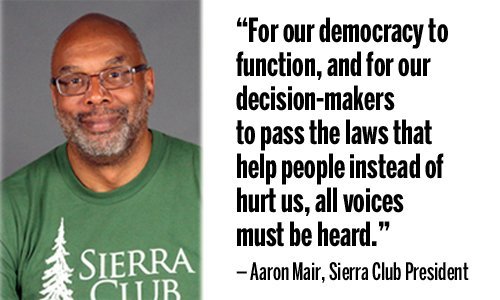
Sierra Club President: ‘To Protect Our Environment and Our Communities, We Must Protect Our Democracy’

People might wonder why a public health professional from upstate New York traveled to Roanoke, Virginia this week.
While I do spend my days disease-mapping for the New York State Department of Health, I also volunteer as the national president for the Sierra Club, the nation’s oldest and largest environmental grassroots organization; and also the NAACP, the nation’s oldest and largest grassroots civil rights organization. I went to Roanoke with the Sierra Club and allies from civil rights and other organizations to support a June 25 rally for voting rights marking the second anniversary of the Supreme Court decision in Shelby County v. Holder, which gutted the landmark 1965 Voting Rights Act (VRA).
Since it was passed nearly 50 years ago, the VRA empowered Americans to participate in democratic elections. It ended literacy tests, poll taxes and other tactics designed to keep people of color away from the ballot box. In the 21st century, it protected against new—but no less pernicious—methods of voting discrimination like inequitable redistricting plans, restrictive voter ID laws, elimination of early voting and unfair polling place changes. By protecting voters from these intentionally restrictive laws, the VRA has provided more opportunities for people to participate and have their voices heard in our democracy.
In the two years since the Shelby decision gutted key protections of the VRA, voter discrimination has increased across our nation as voter ID laws, registration restrictions and other discriminatory practices have become increasingly prevalent. Before the Shelby decision, the Justice Department was required to review any proposed changes to voting laws in Virginia to ensure they weren’t discriminatory. This stripped places like Roanoke, the largest city in southwestern Virginia, with a diverse population that is about one-third African American, of its safety net protecting minority voters.
Voter ID laws have cropped up from state to state, creating additional barriers to the ballot box. These laws did not happen by accident. Big polluters have supported shadowy organizations like the American Legislative Exchange Council, known as ALEC, which are pushing state laws that further suppress the vote across the country in a cynical attempt at gaming our electoral system.

 233k
233k  41k
41k  Subscribe
Subscribe 
